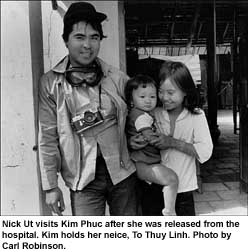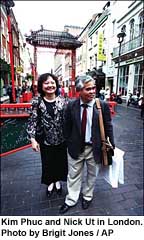|
Kim Phuc and Nick
Ut Meet Again
by Horst Faas and Marianne Fulton
 During
the war Nick Ut visited Kim Phuc several times after she had returned
to her home village of Trang Bang in November 1972. "I used to stop
by and ask how Kim was doing. The family was living in a smaller
house." He said. During
the war Nick Ut visited Kim Phuc several times after she had returned
to her home village of Trang Bang in November 1972. "I used to stop
by and ask how Kim was doing. The family was living in a smaller
house." He said.
When the fall of Saigon to North Vietnamese
troops was imminent Nick Ut was evacuated and finally landed in
the United States.
He met Kim Phuc again - it was seventeen
years after the dramatic day in Trang Bang and fourteen years since
he saw her last a few weeks before the end of the war.
"The Los Angeles Times Magazine wanted
to do a story about Kim Phuc and me and I told them that Kim is
in Cuba, studying Spanish and being trained as a pharmacist. So
we went to Cuba, and I saw Kim again. She introduced me to her fiancee,
a student from North Vietnam." Nick explains. She married Bui Huy
Toan in Cuba.
 Reminiscing
about the 1989 re-union in Havana while meeting again in London
a few weeks ago Kim Phuc said: "For many months in hospital I just
lived in great pain. I cannot remember much, just the pain. But
then the pain subsided, and I could go back home to Trang Bang.
For the first time I really looked at myself, and my first thought
was that with a scarred body like mine I would never have a boyfriend.
Fortunately that wasn't so - and I could introduce 'Uncle Nick'
to my boyfriend, who is now my husband and father of my two sons." Reminiscing
about the 1989 re-union in Havana while meeting again in London
a few weeks ago Kim Phuc said: "For many months in hospital I just
lived in great pain. I cannot remember much, just the pain. But
then the pain subsided, and I could go back home to Trang Bang.
For the first time I really looked at myself, and my first thought
was that with a scarred body like mine I would never have a boyfriend.
Fortunately that wasn't so - and I could introduce 'Uncle Nick'
to my boyfriend, who is now my husband and father of my two sons."
A Korean friend of the couple paid
for a honeymoon vacation out of Cuba in Moscow in 1992. On the return
flight from Moscow to Havana both Kim Phuc and her husband defected.
After they had walked off the plane in Gander, Newfoundland, Canada,
Nick Ut talked to Kim Phuc on the phone. "She was so happy," said
Nick Ut.
Nick Ut visits Kim Phuc and
her family often in Toronto. "Kim and I are almost like family,
she calls me "uncle" and I talk with her almost every week" he said.
AFTER THE WAR ENDED
Who Dropped the Bombs?
The story of the heart wrenching "Napalm
Girl" photograph was accurately and in detail reported in the immediate
aftermath of the incident. The news agency and newspaper stories,
including those of Peter Arnett and Fox Butterfield reported independently
that the incident was involving only Vietnamese and happened during
an all-Vietnamese fight. The only foreigners, among them also
Americans, were the reporters on the scene.
The airstrike had been requested by
a commander of the Vietnamese 25th Army Division and was provided
by the exclusively Vietnamese co-ordinated and controlled 518th
Vietnamese Airforce Squadron (VNAF), with
Vietnamese pilots in the cockpits.
Unlike in previous years of the war both the ground units and the
Airforce Squadron had no U.S. advisors attached to them anymore.
In June 1972 the "Vietnamization"
of the war had been almost completed and most American fighting
forces and men had been withdrawn. By March 1973 all US combat forces
had left Vietnam and the Vietnamese fought on their own, until defeat
in 1975.
Since the war ended in 1975 the Vietnam
war myth was created that the air-strike was in fact ordered, co-ordinated
or even flown by American commanders and pilots. In 1996 a former
U.S. Army captain (John Plummer, now a Methodist minister) even
claimed and "confessed" to have taken part in the air-strike, later
only claiming to have ordered the attack. His claim was thoroughly
investigated and discredited a year later. He had lacked authority
to communicate with the Vietnamese Airforce at the time of the incident.
A reader of the International Herald
Tribune in a letter to the editor wrote to end the discussion
of the question who dropped the bomb: "it is good for the facts
to be set straight. However, the power of the photo has nothing
to do with who was responsible. It results from the depiction of
the unimaginable pain and suffering that war brings to all who play
a role in its ugly chain of events." (Letter by Kevin B. Marvel,
Alexander, Virginia, IHT, July 11, 2000).
|